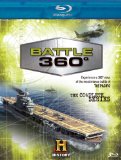“USS Enterprise, aka The Big E, a fighting city of steel. She is the most revered and decorated ship of World War II. On this 360-degree battlefield, where threats loom on the seas, in the skies, and in the ocean depths, The Enterprise’s enemies could be anywhere. Now follow this sea-bound band of brothers through four years of hell. From Pearl Harbor to the doorstep of Japan, there’s nowhere to run, when the war is all around you.”
These are the voyages of the aircraft carrier, Enterprise. Her four-year mission: to explore strange new seas, seek out and destroy the enemy, to boldly go where no carrier has ever gone before. Cue the music. While all of us are familiar with the fictional voyages of the starship Enterprise, few of us know the incredible tale of the World War II aircraft carrier that gave her her name. It’s really a story as thrilling as any that James T. Kirk might tell. She participated in every major battle in the war. For a time, she was the last remaining carrier in the entire Pacific fleet. She was bombed and nearly destroyed in at least three raids. She missed being attacked at Pearl Harbor by less than 24 hours. If not for an unexpected storm, she would have been a sitting duck for the surprise attack that took out a significant portion of the Pacific Fleet before the war had even started for America. That doesn’t mean that her aircraft didn’t participate in the fight. She was 200 miles away and closing when the raid came. Her planes participated in the attempted defense of Pearl Harbor. It was the first battle of the war, and although Enterprise wasn’t there, she participated in the battle and helped mitigate the damage. It was an incredible tale of epic heroism…but it would only be the beginning.
The series covers those four years in the operation of Enterprise with amazing detail. We learn not only of the battles, but what life was like for the sailors and pilots that made the floating city their home. The material is presented through an impressive combination of archive footage, computer generated re-enactments, and the voices of surviving men who were there when it all happened. There are times the footage blends seamlessly, and it’s hard to pinpoint the exact place where the source shifted. There are also pieces where the CG is quite obvious, most notably when humans are depicted. There is careful reproduction of the ships and aircraft from the era that are startling in their accuracy and detail. Unfortunately, much of the same footage is reused countless times. It might not appear so obvious when you watch the show once a week. When you try to watch the entire run over a couple of days, the pieces do stand out.
All of the major action is included here. The Enterprise had a front-row seat for most of the war’s biggest Pacific battles: The Dooley Bomber Raid, Midway, Guadalcanal, Santa Cruz Islands, Gilbert Islands, Truk Atol, Saipan, Leyte Gulf, which was the largest naval battle in human history, Iwo Jima, and Okinawa. The episodes cover the times we almost lost her. The ship’s various repair and refit operations are completely detailed here. The episodes also recap what else is going on in the Pacific to put these moments into perspective for the entire war. She was the first US naval vessel to operate at night. By the time the war was over, the Japanese learned to fear the ship they called The Grey Ghost.
World War II buffs will like this unique take on the events. They can be sure of the stories because they are told by men who were there. The film treats the material with respect, if a bit of a flair for the dramatic. But, of course, these times were dramatic. This will make a rather nice addition to your World War II collection.
Video
Each episode is presented in its original aspect ratio of 1.78:1. The 1080p image is arrived at with an AVC/MPEG-4 codec. There is archived footage here, so you should expect the picture to vary in its quality. This does not look as good as the World War II In HD series did. The CG work is very clean and detailed, but it doesn’t have quite the sense of documentary that the previous series gave us. The picture is often a bit soft on the CG moments. Detail is good, but colors appear muted. It does look somewhat animated. The interview segments look the best. You can really see into these warriors’ minds and get a sense of the emotions they carry nearly 70 years later.
Audio
The DTS-HD Master Audio 2.0 is all about the narration. You’ll hear everything clearly. There’s no added intensity to the war footage. The presentation here is straightforward all the way down the line.
Special Features
Bonus Footage
Final Thoughts:
The Enterprise might have survived the Japanese Fleet, but it could not survive peacetime. The ship was sold for scrap soon after the war ended. There was a great effort to save her as a museum or some such monument, but it all fell on deaf ears. Not even Admiral Halsey himself could save the ship from her ultimate fate. It’s a tearjerker for her surviving crewmen even to this day. They shouldn’t be quite so sad, however. History has just given them the immortal monument the ship so richly deserved. It won’t weigh anchor anytime soon, but you can display it in your own home video collection. Whenever you want, “we can reach out and we can touch them”.





